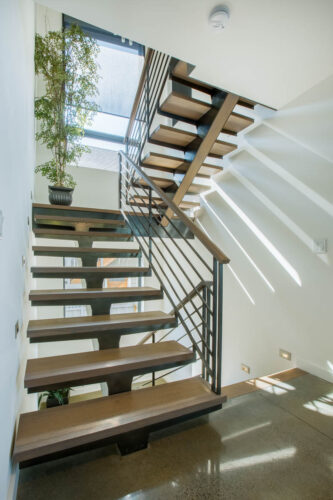Rainwater Harvesting
How much do you pay for water every year? How much do you use? According to the United States Environmental Protection Agency, the average household uses around 45,000 gallons of water per year for cooking, cleaning, drinking, washing, flushing, and watering their plants. For most people in and around Seattle, this water is pumped from several miles away and treated chemically at significant expense to both the consumers (such as yourself) and the ecosystems that this water is taken from. Seattle averages around 38 inches of rain per year. On a 1200 square foot roof of a house, that equals over 25,000 gallons of water falling on your house, only to be quickly rushed off to the nearest storm drain and delivered to Puget Sound as quickly as possible. If this house is on a 4000 square foot lot, a total of nearly 95,000 gallons of rain falls on the site annually, and most of it doesn’t stay long.
The solution seems apparent. Why not use the water that’s already here? Rainwater is our purest available source of water and using it over municipal sources saves you money and leaves a little more water at the source for other people, plants, and animals to benefit from.
The simplest and cheapest way to start using the water falling on your roof is to build a Rain Barrel at the base of one or more of the downspouts around your home. You only need a plastic barrel with a spigot o r hose installed near the bottom (leave some room for debris that will settle to the very bottom of the barrel), an opening or valve near the top to direct overflow from the barrel away from your house (preferably to a thirsty fruit tree or berry bush), and some sort of sealed lid on top to keep critters and curious children from falling in. While this water will not technically be clean enough to drink, cook, or clean with (this requires additional filtration to meet government code standards), you can save a lot of municipal water and money using this water to irrigate your lawn, bushes, trees, or even your vegetable garden. It is even possible to chain two or more barrels together with connected overflow valves to increase how much water you can hold on to at a time, which is good for a place that rains all winter but gives you virtually nothing when you need it in the summer. Additionally, you can save even more of your clean drinking water for drinking if you can find a way to flush your toilet with rainwater (flushing toilets uses more water than almost anything else in your house!). Lastly, if you are going to use your roof to collect rainwater, check what kind of material the roof is made of. This is important, because things like asphalt shingles and chemically treated wood roofing contain toxins that may contaminate the water in trace amounts, making vegetable garden irrigation a risky endeavor. You may also consider this when re-roofing or building a new roof for your home or any garages and sheds (all potential water collectors!).
r hose installed near the bottom (leave some room for debris that will settle to the very bottom of the barrel), an opening or valve near the top to direct overflow from the barrel away from your house (preferably to a thirsty fruit tree or berry bush), and some sort of sealed lid on top to keep critters and curious children from falling in. While this water will not technically be clean enough to drink, cook, or clean with (this requires additional filtration to meet government code standards), you can save a lot of municipal water and money using this water to irrigate your lawn, bushes, trees, or even your vegetable garden. It is even possible to chain two or more barrels together with connected overflow valves to increase how much water you can hold on to at a time, which is good for a place that rains all winter but gives you virtually nothing when you need it in the summer. Additionally, you can save even more of your clean drinking water for drinking if you can find a way to flush your toilet with rainwater (flushing toilets uses more water than almost anything else in your house!). Lastly, if you are going to use your roof to collect rainwater, check what kind of material the roof is made of. This is important, because things like asphalt shingles and chemically treated wood roofing contain toxins that may contaminate the water in trace amounts, making vegetable garden irrigation a risky endeavor. You may also consider this when re-roofing or building a new roof for your home or any garages and sheds (all potential water collectors!).
This strategy can go a long way, but it only scratches the very surface of everything you could do with the thousands of gallons of local rainwater that is available to you (and that nobody will charge you a monthly fee for!). With adequate research and an up-front investment beyond plastic barrels and garden hoses, you can use your rainwater for everything you currently pay to use water for and more! If you are planning to remodel or add to your home, and especially if you plan build a new one, rainwater harvesting technology could be seamlessly integrated into your home for a smaller additional cost than you might expect. For those curious beyond reading this blog, Brad Lancaster’s “Rainwater Harvesting for Drylands and Beyond” books are an easy way to start learning about the possibilities of harvesting and using rainwater.
Equation for calculating rainfall volumes (credit: “Rainwater Harvesting for Drylands and Beyond” by Brad Lancaster):
Roof or Site Area (in square feet) X Average Annual Rainfall (in feet) X 7.48 (to convert cubic feet to gallons) = Total Rainwater (gallons)
By James Drumwright IV, Architectural Designer at H2D Architecture + Design


